
By Paul Gionfriddo, President and CEO, Mental Health America
Throughout the world, people are worrying about the coronavirus and COVID-19, the disease it causes.
Flight reservations are being cancelled. Travelers are coming home. And nearly two dozen IT conferences alone have been cancelled or postponed.
The threat from COVID-19 isn’t insignificant. Most cases seem mild, but at present slightly more than 3 percent of the people who have contracted it have died from it. That makes it significantly more deadly than the flu, although far less widespread.
Congress is taking this seriously. It has appropriated $8 billion to respond.
But the virus isn’t only taking a toll on the nation’s physical health. It is taking a toll on our mental health. And it would be a mistake to think that the clinical anxiety that may be resulting from worries about the virus is insignificant and not worth our attention.
Clinical anxiety is a serious health condition. Its panic attacks can mimic heart attacks. When severe, it can be debilitating or worse. It can land people in hospitals. It can deprive people of hope. And take lives.
While it is still early in the pandemic process, people are clearly worried about COVID-19. But are these worries leading to an increase in clinical anxiety?
Until now, no one has been able to answer a question like this because no one was collecting real-time mental health data. That’s what made “worry” seem inconsequential – we knew nothing about it beyond anecdotal evidence.
But now, for the first time ever, Mental Health America (MHA) is gathering real-time tracking data that may help unlock the answer.
In 2014, MHA began collecting data from our free, online screening program. Among our evidence-based screens is the GAD-7, the most common screening instrument used to assess and help diagnose Generalized Anxiety Disorder.
We examined our anxiety screening data from February, and here’s what we found: more people are screening for clinical anxiety as worries about COVID-19 intensify.
During the first half of the month, 4,213 people took our anxiety screening. During the last half, the number increased by more than 18 percent, to 5,013. This was the most significant increase in the use of any of our mental health screening tools.
Two things happened during those two weeks. The spread of the virus became more dramatic and – in a related event – the stock market crashed.
We went back to December 2018, to see whether the economic uncertainty – as opposed to the fear of the virus itself – might be causing the uptick in anxiety screening. In December 2018, our anxiety screening numbers were down considerably compared to November 2018 and January 2019, suggesting that it is not the economy that is pushing the anxiety.
We also looked at the severity of the screening results. Every month large percentages screen at a “severe” level for the condition for which they screen. In the case of anxiety, that is historically 40-45 percent of anxiety screeners. That’s because help-seekers tend to be unwell already.
During the latter part of February, the severity rate remained in our historic range.
This suggests that the additional anxiety screeners were not “worried well.” They were no less severely ill than our usual screening cohort.
It is too early to draw any conclusions about the total health or mental health impacts we might experience because of the coronavirus. We don’t know what these will look like a week from now or six months from now.
But it is also far too early to dismiss the potential mental health effects as unimportant, insignificant, or inconsequential.
Public health officials are monitoring the spread of the illness. They are advising that we wash our hands frequently and limit our exposure to sick people to protect our physical health. And government officials are putting a lot of money behind the effort.
They should also be monitoring the anxiety resulting from COVID-19 because that could be debilitating or worse to the most vulnerable subset of the population. They should be advising that we take appropriate precautions to reduce as much overall stress as we can and to act quickly when worry transforms to anxiety. And they should be putting some of that $8 billion behind the effort.
In the meantime, MHA will continue to collect data in the coming weeks. We will share what we learn. We hope that the scare, the worry, and the anxiety will abate over time. And we will continue to offer a wide variety of free resources to anyone who needs them at mhascreening.org.




